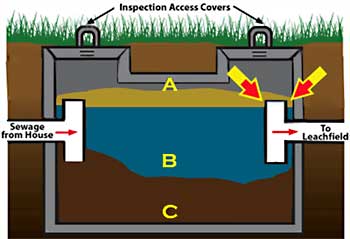In our first blog in this series, we discussed the functioning of a healthy septic tank. Today, we’ll discuss what happens when septic tank problems arise.
The Beginning of Septic Tank Problems
 After several years of use, a build-up of bottom sludge (C) and floating scum (A) will reduce the effective capacity of the tank, as shown in the “Unhealthy Septic Tank” illustration. This means waste passes through the tank too fast, and solids eventually plug the pipes in the drainfield. This overfilling of the tank can occur many times over a span of years or even day to day.
After several years of use, a build-up of bottom sludge (C) and floating scum (A) will reduce the effective capacity of the tank, as shown in the “Unhealthy Septic Tank” illustration. This means waste passes through the tank too fast, and solids eventually plug the pipes in the drainfield. This overfilling of the tank can occur many times over a span of years or even day to day.Heavy water use such as laundry days or entertaining guests taxes your system and introduces solids into the drainfield. This is when your drain field becomes filled with water. By the time either untreated effluent begins surfacing on the ground or sewage backs up into house drains, you have a full blown problem. These are common signs and symptoms and the outward appearance of a septic problems that could have existed for years.
Early Signs of Septic Tank Problems
The early signs and symptoms of septic tank problems are usually unnoticed by the time the outward appearance and visible signs occur the problem has moved to your drain field.
- You can suspect the problem is the drain field if:
- There are odors or persistent wet spots over the field.
- The plumbing becomes sluggish over a period of time, or when it’s used heavily, or during wet months
- Problems persist even though the tank has been pumped recently
- The septic tank is flooded